INTRODUCTION
Thread lifting1 has become an increasingly popular medical procedure. The primary purpose is to fight gravitational ptosis of the skin and to move the tissue up in a natural non-traumatic way. Thread lifting of the midface soft tissues has been shown to be an effective method for rejuvenating the ageing face.2,3 At present mostly used are polydioxanone (PDO) threads (duration period 4-8-months), PLLA threads (6-10-months), PLLA/PLC threads (18-24-months). Threads composed of the copolymer poly-L-lactic acid (PLLA) and polycaprolactone (PCL) (anti-ptosis, APTOS, Tbilisi, Georgia) have an additional advantage. By the slow and gradual release of PLLA, a potent stimulator of collagen production, they induce a long-lasting biostimulating effect. As a result, the patient not only has an instant improvement in the shape of their face but also a faster rejuvenating effect with thicker, glowing skin. Consequently, there is a possibility of avoiding or delaying traditional surgical lifting.4
The popularity of thread lifting among practitioners and patients has boosted research in this area. A new absorbable thread made from PLLA/PCL enriched with native hyaluronic acid (HA) has recently been produced and has triggered significant interest among aesthetic practitioners. It is well-known that HA is the ideal biomaterial for wound healing.5,6 Moreover, it has many beneficial effects as it also acts as an anti-oxidant and moisturiser. The addition of native HA to PLLA/PCL threads may improve a patient’s sensations in the post-treatment period, and it is having wound healing properties and other unknown benefits.
The aim of this observational single-blind study was to compare the aesthetic outcome of armouring procedures using absorbable PLLA/PCL threads with the same procedure performed with PLLA/PCL/HA threads in terms of rejuvenation. Moreover, the study has the objective to understand if the addition of HA could decrease the downtime (post-treatment discomfort) of the procedure in terms of subjective evaluation made by the patients. The assessment of outcomes in aesthetic medicine is especially pertinent because patient satisfaction is the predominant factor determining success.
METHODS
Study Population
Eight patients (35-62-years-old; seven females, one male) with signs of gravitational ptosis and mild to severe wrinkles were selected for the study. Exclusion criteria included: previous implants of non-absorbable fillers, autoimmune disease or infection in the treatment area. All patients gave their written informed consent before taking part in the study. The study was carried out in accordance with the guidelines laid down in the Declaration of Helsinki, 2013.7
Procedure
All patients underwent thread insertion after clinical examination. Treatment consisted of thread implantation into the subcutaneous tissue to improve the oval shape of the face and provide longlasting biostimulation.
After disinfection of the whole face, local anaesthetic was injected into the mid and lower third of the face (5 ml of 1% lidocaine with epinephrine on each side). Two points of insertion, one in the zygomatic area and one in the pre-auricular area, were created using an 18-gauge needle.
Absorbable threads, 19 cm long, with multidirectional barbs comprised of PLLA/PCL or PLLA/PCL/HA (APTOS, Tbilisi, Georgia) were used in the study. The threads were charged into 15 cm long cannulas with a round atraumatic tip. One side of the face was treated with five PLLA/PCL threads and the other with five PLLA/PCL/HA threads. The patients were unaware of the type of threads used on each side. Follow-up assessment took place 7, 30 and 90 days after the procedure.
Methods of Evaluation
A 5-point rating questionnaire answered by patients was used to assess pain, swelling, burning sensations and skin irregularities on each side of the face immediately after the procedure and after 7 days (Table 1). The choice of the parameters to evaluate subjectively depends on the fact that exactly these four characteristics represent the most frequent complains of the patients after the thread lifting. The perceptions of the patients on each side of the face were compared with the data of the practitioner in order to link them to the type of threads inserted.
| Table 1. Patient Questionnaire and Rating Scale Used Immediately and 7-Days after the Procedure |
|
PLLA/PCL
|
PLLA/PCL/HA
|
| Pain |
1 2 3 4 5
|
1 2 3 4 5
|
| Swelling |
1 2 3 4 5
|
1 2 3 4 5
|
| Burning |
1 2 3 4 5
|
1 2 3 4 5
|
| Skin irregularities |
1 2 3 4 5
|
1 2 3 4 5
|
| 1: absent; 2: mild; 3: moderate; 4: severe; 5: intolerable |
Wrinkles were evaluated objectively using skin care analysing 3D photosystem software (LiveViz, QuantifiCare Inc., CA, USA) 7, 30 and 90 days after treatment.
Statistical Analysis
The subjective data of the patient’s perceptions was evaluated using Student’s t-test to compare means. Expected value μ is the probability-weighted average of all its possible values. Statistical significance was determined at a p<0.05. The degree of wrinkle improvement was assessed statistically with standard deviation. RESULTS No significant adverse reactions have been reported. The patients were asked to evaluate their pain, swelling, burning sensations and p<0.05. The degree of wrinkle improvement was assessed statistically with standard deviation.
RESULTS
No significant adverse reactions have been reported. The patients were asked to evaluate their pain, swelling, burning sensations and skin irregularities immediately after treatment and after 7 days (Table 2). Total score right after the procedure was 2.66 for the side treated with PLLA/PCL threads and 2.50 for the side treated with HA-enriched threads (Table 2). This result means that the patients evaluated the discomfort after the treatment between “mild” and “moderate” in each treated side of the face regardless the type of the thread used. In fact, there were no statistically significant differences in patient perceptions between the two sides of the face (p=0.650) (Figure 1).
| Table 2. Mean Scores for the Main Assessment Criteria Immediately after and 7-days after the Procedure (n=8) |
|
Immediately after
|
7-days after
|
|
PLLA/ PCL
|
PLLA/PCL/HA
|
PLLA/ PCL
|
PLLA/PCL/HA
|
| Pain |
2.50
|
2.38
|
1.75
|
1.13
|
| Swelling |
2.75
|
2.63
|
1.25
|
1.0
|
| Burning |
2.38
|
2.25
|
1.25
|
1.13
|
| Skin irregularities |
3.0
|
2.75
|
1.50
|
1.13
|
| Total score |
2.68
|
2.50
|
1.44
|
1.09
|
| 1: absent; 2: mild; 3: moderate; 4: severe; 5: intolerable |
Figure 1. Statistical Significance of Differences in Subjective Parameters Immediately after and 7 Days after the Procedure

All parameters improved significantly 7 days after the procedure (Table 2). Total score was 1.44 for PLLA/PCL threads and 1.09 for PLLA/PCL/HA threads (Table 2). The improvement was much more evident on the side treated with the threads enriched with HA. These results are summarised in Figure 2. The difference in subjective sensations between the two sides of the face was statistically significant (p=0.014) (Figure 1).
Figure 2. Treatment Questionnaire Results
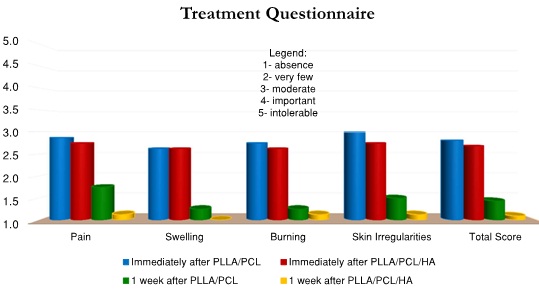
It’s evident that there was a significant difference in patient’s perceptions between the two sides of the face treated with different threads: 7 days after treatment the side treated with PLLA/PLC/HA threads presented less pain, less swelling, less burning and faster disappearance of skin irregularities (Table 2, Figure 2). This confirms the hypothesis that the addition of HA to PLLA/PCL threads provides less post-treatment discomfort and a shorter downtime.
The second step of the aesthetic evaluation was performed using skin care software. The 3D photosystem LiveViz (QuantifiCare Inc., CA, USA) was used to document the changes in wrinkles 7, 30 and 90 days after treatment. This system automatically analyses different skin parameters (wrinkles, pores, spots, etc.) (Figure 3a) by choosing the same anatomical area (right cheek, left cheek and forehead) in the picture of the patient at each control (7, 30, 90 days). For the study, only wrinkles were taken into consideration. The improvement in wrinkles on each side of the face was determined using standard deviation comparison (Figure 3b).
Figure 3a. Example of the Assessment of Skin Parameters Using Skin Care Software (3D Photosystem LiveViz; (QuantifiCare Inc., CA, USA)
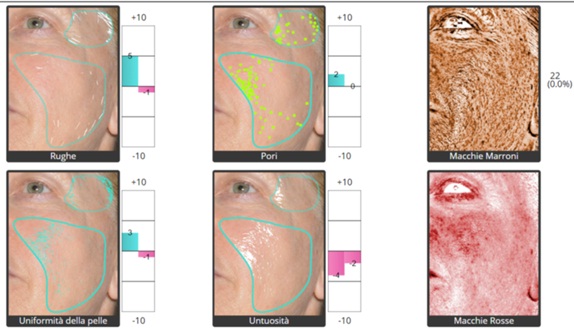
Figure 3b. Interpretation of Results Using the Skin Care Software System and Standard Deviation
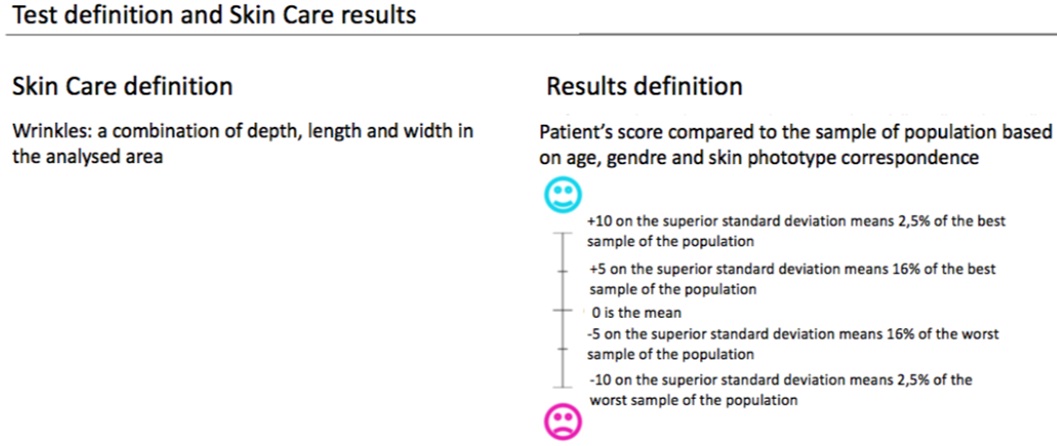
An analysis of the database showed good improvement of wrinkles on both sides of the face, regardless of the type of threads used. The wrinkle condition at baseline (before treatment) put the patients in the group of 17.4% of the sample population with the worst wrinkle condition (score=-4.69) (Figure 4). After 1-month, the patients were put into the group of 49.2% of the sample population with the best wrinkle condition (score=+0.13) with a difference of +4.82 points. The improvement continued up to 3-months and the wrinkles of the patients were then the same as 35.2% of the best sample of the population (score=+1.94), a difference in 6.57 points from the baseline.
Figure 4. Comparison of Wrinkle Conditions of the Patients (The Sum of Both Sides) to the General Population of the Same Age at the Different Assessment Times
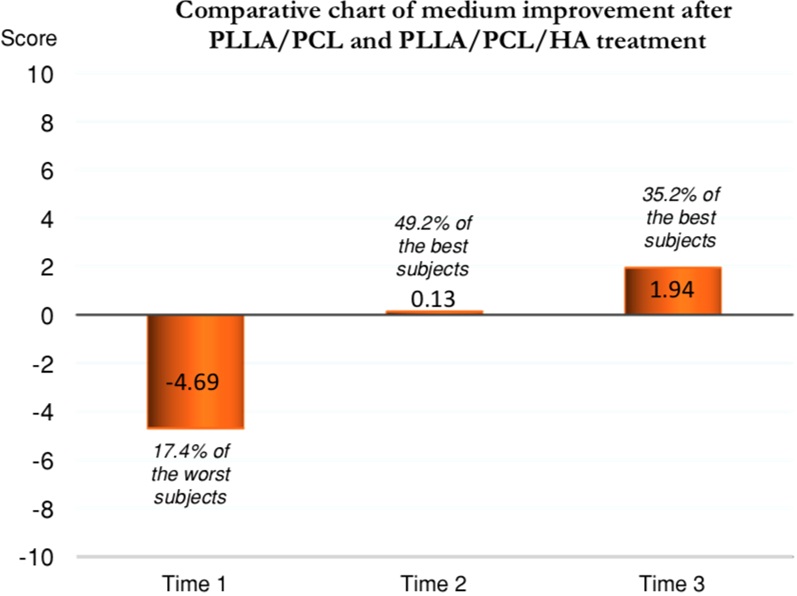
A comparison of the change in wrinkles between each side of the face (Figure 5) showed that the wrinkle condition on the side treated with PLLA/PCL threads improved from a baseline of 17.4% (score=-4.63) of the worst sample of the population to 42.9% of the worst sample of the population (score=-0.88) after 1-month and to 38.2% of the best sample of the population (score=+1.5) after 3-months. Thus, the improvement in score was +3.75 after 1-month and +6.13 after 3-months from baseline.
Figure 5. Comparison of Wrinkle Conditions of Each Side of the Face Treated with PLLA/PCL or PLLA/PCL/HA Threads to the General Population of the Same Age at the DifferentAssessment Times
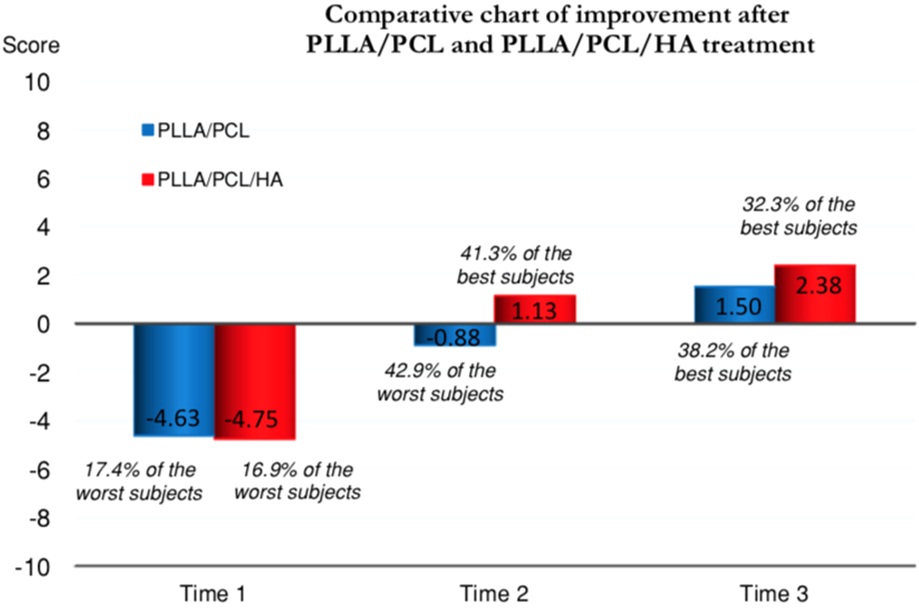
The improvement in wrinkles was more evident on the side treated with PLLA/PCL/HA threads: from baseline of 16.9% (score -4.75) of the worst sample to 41.3% (score +1.13) of the best sample after 1-month and to 32.3% (score +2.38) of the best sample after 3-months. Thus, the improvement was +5.88 after 1-month and +7.13 after 3-months from baseline. These results can be seen clearly in the Gaussian distribution chart (Figure 6).
Figure 6. Gaussian Distribution of the Improvement in Wrinkles with the Two Types of Thread at the Different Time Points
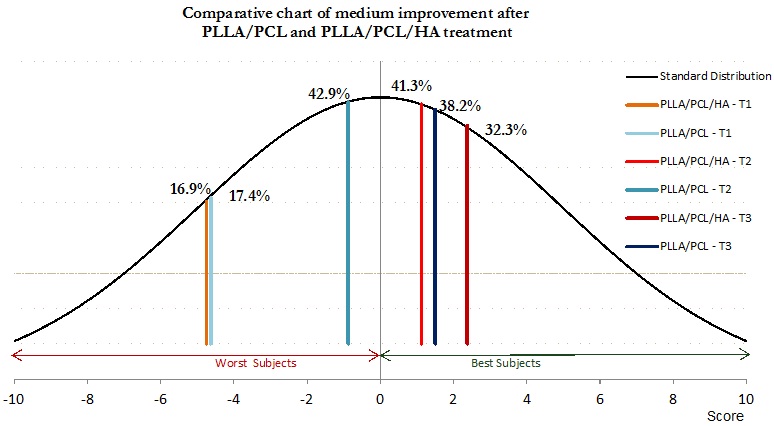
The results of the study are evident in the clinical pictures as well. There is a tangible difference in wrinkle conditions between the right side of the face treated with PLLA/PLC threads (Figures 7a, 8a and 9a) and the left side treated with HA enriched threads (Figures 7b, 8b and 9b).
Figure 7a. The Side of the Face Treated with PLLA/PCL Threads
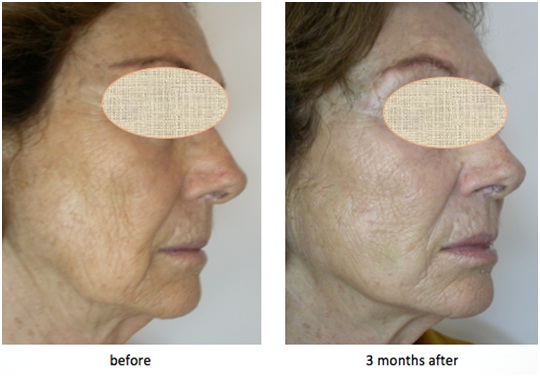
Figure 7b. The Side of the Face Treated with PLLA/PCL/HA Threads
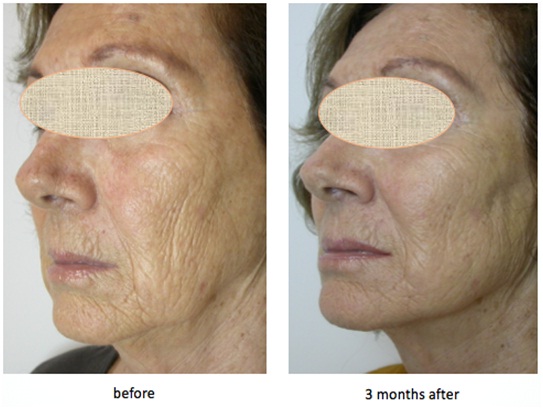
Figure 8a. The Side of the Face Treated with PLLA/PCL Threads
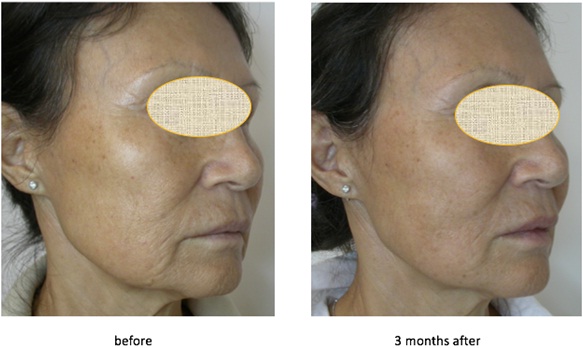
Figure 8b. The Side of the Face Treated with PLLA/PCL/HA Threads
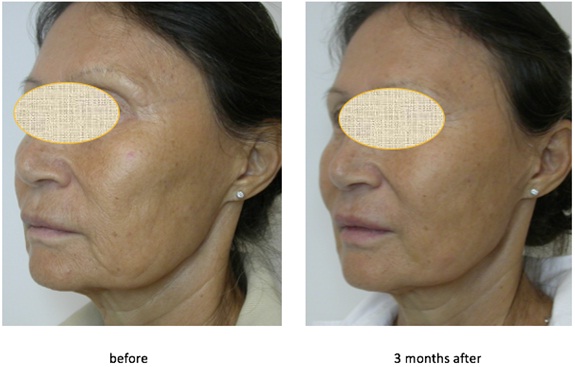
Figure 9a. The Side of the Face Treated with PLLA/PCL/HA Threads
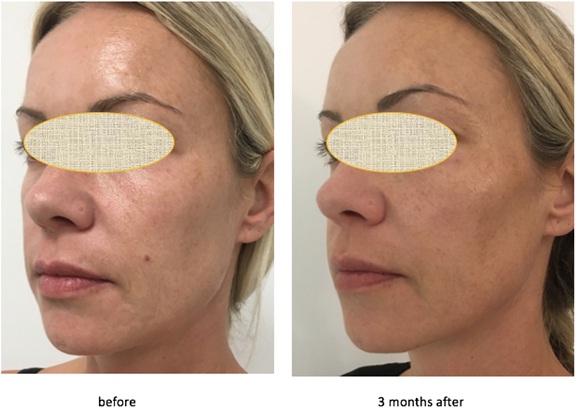
Figure 9b. The Side of the Face Treated with PLLA/PCL/HA Threads
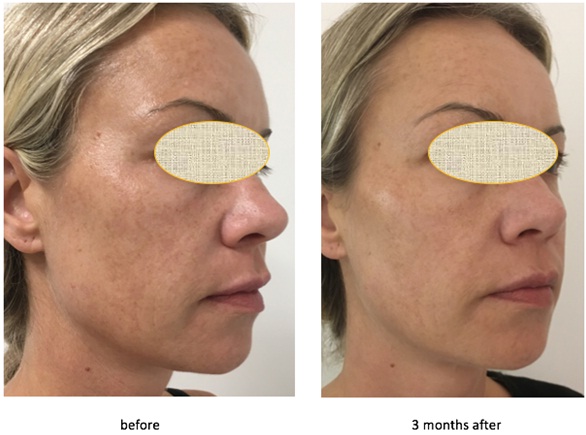
DISCUSSION
The most important advantage of thread lifting is its minimal invasiveness. Absorbable threads generally do not require incisions, so they do not create scars, and the downtime is very short (a few days only). The risk of complications is also very low. These are the reasons why many aesthetic practitioners adopt thread technologies in their practice.
Nevertheless, some sensitive patients complain of discomfort during the period following thread insertion.8,9 The idea of adding HA to the composition of PLLA/PCL absorbable threads originated from a need to minimise these unwanted sensations.
We know that HA has a natural function of providing support to collagen fibres, this makes it ideally suited for use in wound treatment10–12 and consequently for the improvement of healing processes after threads insertion.
In our study, we compared PLLA/PCL and PLLA/PCL/ HA threads treatment outcomes. We performed a split-face procedure and evaluated first, the post-treatment subjective perceptions of the patients, then an objective effect on wrinkles conditions, rejuvenating effect, in each side of the face.
As the study demonstrates, the addition of HA results in a more comfortable post-treatment period, the unwanted subjective perceptions of the patients disappear faster. Evidently, due to the bioactive behaviour of HA, the healing process after thread insertion is shorter (Figure 2).
As for the rejuvenation, the role of HA in rejuvenation process is widely confirmed.13–15 The data show that it is safe and effective method of the skin hydration, since it possesses a large water binding capacity.16
It also plays an important role in exchange between cells and blood and for cell migration. Moreover, via the CD44 receptor, it is capable of increasing cell differentiation.16
In accordance with the consensus of an interdisciplinary team of experts consisting of dermatologists and plastic surgeons16 we selected one of the target parameters of rejuvenation with native HA, wrinkles conditions. In fact, our study showed by objective evaluation of wrinkles conditions, that the improvement is more evident in the side treated with threads enriched by HA. It arrives faster as well.
CONCLUSION
There was a significant difference in patient’s perceptions between the two sides of the face treated with different threads: 7 days after treatment the side treated with PLLA/PLC/HA threads presented less pain, less swelling, less burning and faster disappearance of skin irregularities (Table 2, Figure 3). This confirms the hypothesis that the addition of HA to PLLA/PCL threads provides less posttreatment discomfort and a shorter downtime.
Regardless of their composition, absorbable threads with multidirectional barbs are an effective method for the treatment of wrinkles. The addition of HA boosts skin rejuvenation with more evident wrinkle improvement as demonstrated by the data of the objective evaluation.
Absorbable threads consisting of PLLA/PCL/HA represent a new step in decreasing the invasiveness of thread lifting with the additional advantage of providing faster rejuvenation and an improved aesthetic outcome.
LIMITATIONS OF THE STUDY
The sample of the population investigated was small, so other studies are requested to confirm our results.
INFROMED CONSENT STATEMENT
The authors have received written informed consent from the patients.
CONFLICTS OF INTEREST
The authors declare that there are no conflicts of interest regarding the publication of this paper.


















